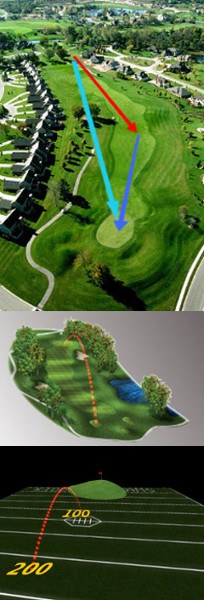
In Part I of this feature, we discussed the concept of the comfort zone. Now let's look at how you can leave your current zone and open new possibilities for your game.
First and foremost, it's imperative to establish a “process vs. outcome” mentality on the course. (Click the link to learn more about this approach.) In essence, it's all about staying in the moment, focusing on the shot at hand, controlling the things you can control and letting the results take care of themselves.
Concentrating on your immediate task helps keep out distracting thoughts – If I par in from here I'll shoot a career round, for instance.
Next, forget about “protecting” a good score, which leads to defensive play and tentative swings and strokes. Playing not to make bogeys, instead of aggressively pursuing birdies and pars, is a sure way to slide back into your comfort zone. Push yourself to go lower – you've got the game to do it, or you wouldn't be in this position.
Here's an excellent way to break your comfort zone's confines: Stack the deck in your own favor. For example, play a round from the forward tees, or play with two balls, counting your best on each hole. There's a good chance you'll score several shots better than normal, beat holes that typically have your number, and walk away with a new sense of confidence.
Yes, you'll know the score was achieved under easier conditions. But you'll also know how it feels to “go low” – and that's a powerful tool for breaking free from your comfort zone.

How to Break Out of Your Comfort Zone – Part II
In a previous article, we discussed a variety of ways in which you could break out of your comfort zone in the game of golf. Here, we are going to continue on with that topic, offering a number of additional suggestions. Since golf is a game that can last a lifetime for many people, it is important to think of ways to keep the game 'fresh' moving forward. If you just do the same old thing time after time when you visit the course, you might find that your enjoyment and interest in this great hobby wanes over time. And that would be a shame.
To review, we hit on four main points in the previous article. Those were as follows –
- Playing new golf courses
- Learning to hit new shots
- Playing in tournaments
- Finding new playing partners
Each of these suggestions can change the game for the better in a meaningful way. When you get the chance to visit a new course, for example, it will be like discovering golf all over again. You'll have to pick the best lines off the tee, plan out your approach shots carefully, and learn the speed of the greens on the fly. This is a fun experience for any player, and it is one that you should seek out as often as possible.
With regard to hitting new shots, this is a great way to challenge yourself to keep improving, no matter how long you have been playing golf. If you are simply satisfied with your game the way it is, you will quickly get tired of hitting the same old shots and shooting the same old scores. By learning to hit a fade rather than a draw, or vice versa, you can expand your skills and make the game more interesting.
Speaking of a challenge, that is exactly why you would sign up for a tournament at your local club or with your local golf association. It isn't so much about proving that you can beat other players as it is about proving that you can play well under pressure. Everything will seem just a little bit harder when you enter a tournament – and that is a good thing, indeed. You want to test your limits in the game to see how good you can be when there is something on the line. Many golfers who enter just one or two tournaments for a taste of the experience find that they keep coming back time and time again because the competition is such a rush.
Finally, the last point we offered up in the previous article related to finding new playing partners. This is another excellent idea, as it will open you up to new experiences on the course. Simply by telling those working in the pro shop that you would like to be paired up with a new group, you should be able to make new acquaintances on the course – and perhaps form lasting friendships.
Moving on, the content below will contain some additional thoughts on how you can get out of your comfort zone on the golf course. These new points should not be considered a replacement for the ideas above, but rather an addition. Use any of the ideas that you feel will best serve your interests moving forward. Have fun out there!

Purchase New Equipment
It is a myth that you need to buy expensive golf clubs in order to play well. Plenty of golfers shoot low scores with affordable, and even old, equipment. If you swapped out the high-end gear in a professional golfer's bag for some budget clubs, he or she would still be able to play at a high level. Sure, they might not play quite as well as they do with their expensive gear, but it's not like they would revert back to being a total beginner. Talent and skill are far more important than equipment any day of the week.
With that said, you can open yourself up to new experiences on the links if you are willing to invest in some new equipment. This is more about optimizing your set for your own game than it is about spending hundreds of dollars on name brand items. If you are interested in picking out some new gear, please check out the tips below.
- Fill in gaps in your set. One of the best ways to improve your game thanks to new equipment is to fill in existing distance gaps in your current set of clubs. That means you are going to pick up a new club that 'plugs a hole' you had in your previous set composition. A common example of this is using a hybrid club to cover new distances that you could not handle with long irons. It is common for amateur players to hit some of their long irons – especially the three iron and four iron – the same distance. If that is the case for you, carrying both of those clubs is a mistake. Leave the three iron out of the bag and replace it with a hybrid that you can hit farther than your four iron. You will now be covering a new distance and you'll have the opportunity to hit different shots once out on the course.
- Hit the ball higher. The ability to hit the ball high is coveted in golf because high shots stop quickly. It isn't particularly difficult to hit the ball high with a pitching wedge, but many players struggle to do so with long- and even mid-irons. If you make equipment changes that allow you to send the ball higher into the sky, you will be able to take a more aggressive approach to many of your shots. The ball will not bounce and roll as far after it lands, meaning you can fire at the flag in more situations. Simply hitting the ball higher is not going to guarantee you better scores, of course, but it will open up more possibilities on the course. Once you learn how to use these high shots properly, it would not be a surprise to see your scores come down.
- Achieve a better roll. Most golfers, when shopping for replacement clubs, think first about the driver or maybe a set of irons. Those clubs can be helpful, of course, but so too can a putter allow you to make progress in your game. If you aren't achieving a clean roll with your current putter, finding one which is better suited to your stroke may be a necessary step. The great thing about putters is that it is easy to try out many different models before making your purchase. Stop by your local golf shop sometime and test out a number of different putters for yourself. Unlike picking out a driver, where you should rely mostly on launch monitor data, you can pick a putter simply by look and feel. Trust your instincts and go with the one that instills the most trust in your mind as you stand over the ball.
We don't mean to imply in this section that you should just be trying to buy a better golf game. The effort you put into the game, and the natural ability you carry, will make up the majority of your results. However, the final piece of the puzzle can be nudged into place by finding the right equipment. It isn't about finding the 'best' equipment so much as it is about finding the right equipment for your game personally. If you feel like you are in a rut with your play at the moment, consider looking into equipment upgrades/changes as a way to take a step forward and renew your energy on the course.

Use a New Strategy
The strategy you typically use on the golf course is probably not something you think about very often. For most golfers, the way they approach the game is natural, having developed over years of experience. Some golfers are aggressive, some are conservative, and many fall somewhere in between those two extremes. The style of play you employ on the course probably mirrors your personality to a large degree. Those who are risk takers in real life are usually risk takers out on the fairways, while conservative people tend to play it safe across the board. Neither of these methods is right or wrong, but it is important to understand where you fall on the spectrum.
To break out of your comfort zone during an upcoming round, try altering your playing style dramatically. Obviously, there is no way to know how this is going to work out, so it would be best to do this experiment during a casual round with nothing on the line. You might play just as well as usual, or even better – or you may struggle from start to finish. Whatever happens, you will have conducted an interesting experiment which may alter the way you look at your game.
If you are a naturally aggressive golfer, the plan is going to be playing it safe from the very first shot all the way through to the last. Only use your driver when absolutely necessary, and pick conservative targets to favor keeping the ball in play over all else. You will be laying up on the par fives and short par fours, and you won't aim at pins which are placed closed to hazards. Basically, your goal is to stay out of trouble all day long. You aren't trying to hit spectacular shots, or even set up short birdie putts – you are just playing it safe and keeping the ball in play.
On the other hand, golfers who usually play conservatively should try going for everything over the course of 18 holes. You will be pulling your driver from the bag anytime there is a realistic opportunity to do so, and you will be aiming directly at the flag. The hazards are not going to be a concern to you during this kind of round, because you are only expecting to hit great shots. You should be thinking aggressively from the very first shot of the round on through to the final green.
So what is the point of breaking out of your comfort zone in this manner? Mostly, you are trying to find places where you can change your normal game plan during average rounds of golf. The idea is not to radically change your style permanently – you should already be pretty close to your optimal playing style, just by letting your game naturally develop over time. However, while playing an 'extreme' round with the opposite style, you may spot opportunities to make better decisions.
A good example of this concept is the debate over whether or not to try for the green in two shots on a par five. Many golfers have their mind made up in advance when standing on the tee, just based on the yardage of the hole. You would make better decisions, however, if you were open to seeing what happens after your tee shot has been struck. Those who usually go for the green are sometimes surprised at how well it can work out to lay up, and vice versa. Keep an open mind during these experimental rounds and learn from your experience.





